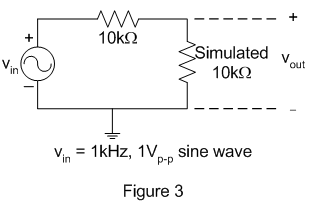EE 212 Lab
Lab 11: Operational Amplifiers,
Negative-Impedance Converters and General Impedance Converters
Prelab 11
Note: 741 op-amps are more forgiving and work better for
this experiment
This lab demonstrates two novel uses of op-amps: negative impedance converters
(NICs) and general impedance converters (GICs). To understand how these circuits
work, you need to analyze them in sinusoidal steady-state operation or using
frequency-domain methods.
1. Negative-Impedance Converters
-
The NIC shown in figure 1 uses a 356 op-amp and resistors to produce an input
impedance of Zin = -Z. Design and build a NIC with
Zin = -10kW. Choose the resistors R
to keep the op-amp supply current from exceeding its maximum for the rated
range of input voltages. Also keep in mind that the op-amp circuit only acts
as a NIC so long as it is not operating in saturation.

-
Put a voltage source and two 10kW resistors in
series with your -10kW NIC and take measurements
to verify that the NIC really behaves as -10kW.
You'll want to take voltage measurements at points in the circuit other than
the op-amp inputs to minimize ringing that can be caused by connection of
a probe.
2. General Impedance Converters
-
Figure 2 shows a GIC which is built using two op-amps and five impedances.
The input impedance of a GIC is given by
Z1 Z3 Z5/(Z2 Z4).

-
Build a GIC to simulate (act as) a 10kW resistor
using two 356 op-amps and five resistors.
-
Use this simulated resistor in series with a real
10kW resistor to build a voltage divider as shown
in figure 3. Drive the voltage divider with a 1kHz, 1V peak-to-peak sine
wave. Does the output look like what you would expect?

-
A typical use of GICs is to simulate inductors. If Z2 or Z4
is a capacitor and the other impedances are resistors, then
Zin is the impedance of an inductor. GICs are used to simulate
inductors because it is virtually impossible to build an inductor as part
of an integrated circuit, whereas op-amps, capacitors and resistors are
relatively easy to build. Modify your GIC such that it acts like a 10H inductor.
-
Use your "ideal'' 10H inductor in the RL circuit shown in figure 4. Determine
the circuit's time constant t. (One method of
finding t is to use an input square wave of period
10t to represent a step input and measure the
10% to 90% rise time from which t can be computed
as in lab 3.)
-
Show that this is the time constant you would expect if the inductor and
resistor were both ideal.
-
Increase the amplitude of the input voltage until the output becomes distorted.
Why does the response of the circuit with the simulated inductor depart from
the ideal response?

© Copyright 2003 New Mexico Institute of Mining and Technology




